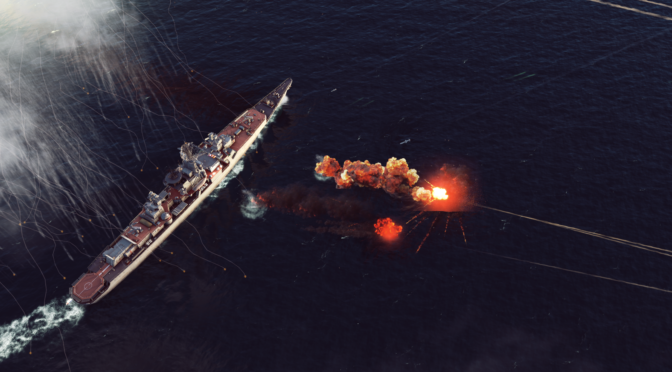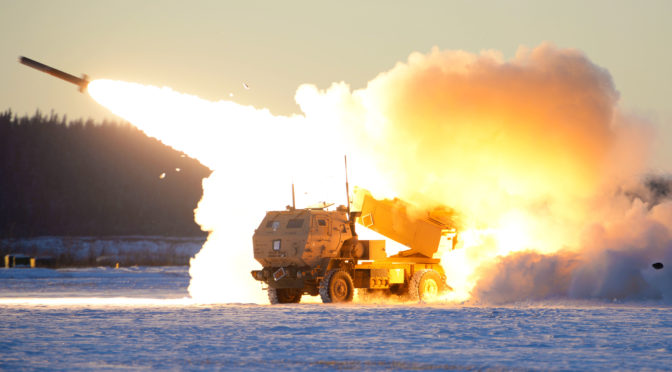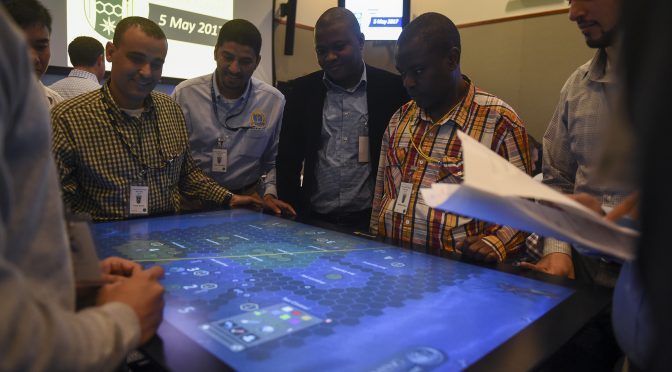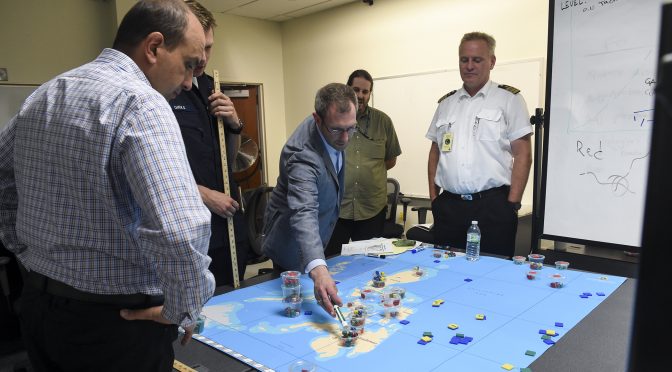By LT Jack Tribolet
Educational wargaming is underutilized and possesses the potential to teach warfighters intricate modern doctrine and force capabilities. Historically, analytical wargaming has functioned as a critical tool for military leadership, offering insights into force capabilities and aiding decision-making through experiential learning. Yet, within the US Navy and Marine Corps, the potential of digital or electronic wargaming as an educational platform for junior officers and Midshipmen remains largely untapped. Traditional tabletop wargames, once favored by older generations, fail to engage the younger, digitally-raised cohort and instead cater to a niche community. Statistics speak volumes— about 80 percent of Generation Z and Millennials play video games and average around seven hours of weekly gametime—highlighting the opportunity for a new generation of wargames. This data underscores a missed opportunity in leveraging simulator-based educational wargaming for the 21st-century Navy and USMC. The capacity to craft a sophisticated, educational, and enjoyable physics-based simulator exists, and it is incumbent upon the Navy and USMC to embrace this modern technology for Professional Military Education (PME) and junior officer training.
In the Fall of 2023, the University of Southern California’s Naval ROTC program embarked on a year-long initiative to introduce Midshipmen to the complexities of the Taiwan problem set. This scenario-focused education requires a significant understanding of naval and amphibious operations and is ideal for incorporating wargames. USC’s educational program blends discussions, lectures, and essential reading materials, such as James R. Holmes’ Red Star Over the Pacific: China’s Rise and the Challenge to U.S. Maritime Strategy (2018), which enabled the students to have an in-depth discussion with Dr. Holmes via Zoom regarding Taiwan. However, it is worth noting that this initiative provides only an introductory-level education for Midshipmen and would benefit immensely from the addition of fleet-integrated educational wargaming.
Historical instances, such as the development of War Plan Orange prior to the Second World War, demonstrate how effective analytical wargaming can be when mixed into scenario decision-making. Yet, no standardized efforts were made to prepare junior officers similarly. The Naval War College and officer training pipelines did not see the value in educating junior officers like senior officers. However, even though junior officers do not require the same analytical gaming experience as fleet commanders, they can benefit enormously from exposure to educational wargaming to introduce them to various topics. As a learning tool, wargames can train the participants in force capability and doctrine, provide terrain familiarization, and offer opportunities for decision-making development. Additionally, they challenge the participants mentally, stimulating and driving sophisticated problem-solving and decision-making. As a tool, variables can be added or subtracted to increase/decrease game complexity, allowing for infinite theoretical scenarios.
Updating the naval officer training curriculum should not be difficult. The United States Naval Academy (USNA) and Naval Service Training Command (NSTC) promulgate curriculum guiding Professional Core Competencies (PCCs) roughly every three years that govern “the foundational standards of ‘officership’ by delineating core competencies required of all officer accession programs.”1 Whispers of a new competency for basic instructional wargaming exist, but even if included in the 2024 PCCs, this will require significant time and resources to train unit Officer Instructors to run educational games proficiently. Additionally, few ROTC courses have extra time, and an already burdened weekly schedule leaves little for adding extra training on top of current requirements for Midshipmen. To the collective groan of students and instructors alike, adding wargaming to officer training will necessitate a standalone time slot in weekly schedules, rather than shoehorning wargaming into existing time. Furthermore, Officer Instructors will need professional training to standardize implementation and enable cross-unit competition.
The Brute Krulak Center for Innovation and Future Warfighting at Marine Corps University (MCU), who are pioneering educational gaming for MCU students, example one potential source of training for Officer Instructors. MCU could integrate with the biannual three-week Teaching in Higher Education (TiHE) course for incoming NROTC instructors, and allow them to reach the hundreds of Sailors and Marines who commission through NROTC each year. Moreover, standardization of training and the games played across ROTC programs is paramount to enable cross-unit integration and competition. Competition in wargaming events would incentivize performance and further stimulate Midshipmen education. The Government Accountability Office recently recommended that the Navy and Marine Corps “evaluate the costs and benefits of developing standard wargaming education and qualifications for wargaming personnel.” Consequently, the services must establish wargaming as an Officer Instructor (OI) qualification to standardize and enhance training pipelines through educational gaming.2 This qualification could mimic the newly introduced Warrior Toughness program, which has gradually become part of the Fleet through accession pipelines. After rotating through ROTC the cadre returning to the Fleet could broaden wargaming initiatives at the unit level, gradually fostering a culture shift towards embracing wargaming more extensively across the services.
However, if the Navy and Marines want to capture the attention of a new generation, they must develop an educational but entertaining multi-dimensional physics-based simulator to maximize the application of 21st-century technology. Tabletop wargaming, while valuable, is not sufficient. Tabletop gaming offers an immediate but temporary avenue for educational learning at a remarkably affordable investment. Straightforward tabletop problem-solving games can be completed within a brief timeframe, ranging from twenty to thirty minutes. An illustrative example is the microgame “Call Sign,” which concentrates on carrier combat and introduces singular variables, showcasing how these games can efficiently impart knowledge and skills, but these games are insufficient to meet the needs of the ROTC curriculum and lack the potential of digital games.
The Office of Naval Research (ONR) sponsored a study on the value of video games, which concluded that “people who play video games are quicker at processing information” and that only “ten hours of video games can change the structure and organization of a person’s brain,” therefore tying informational learning to entertainment has a remarkable potential to increase retention. Most importantly, education must be balanced with entertainment, meaning accurate force capabilities and doctrine must coincide with quality graphical rendering of the action and include regular updates. Simulating forced decision-making with minimal time and minimal information provides invaluable experience for future military decision-makers. Furthermore, an in-depth military simulator would require knowledge of blue force design and doctrine, cultivate warrior skillsets, and increase tactical acumen. A competitive gaming culture amongst recruits and service members will ensure the longevity of such a program.
Effective strategy games blend a minimal initial learning curve but increase in depth and complexity while remaining re-playable due to variety. Like traditional board wargames, turn-based games necessitate a fundamental understanding of force design and doctrine. Conversely, real-time strategy (RTS) games demand swift decision-making, compelling players to act within a restricted timeframe. Modern games often integrate these two approaches, allowing players to oversee larger forces strategically in a turn-based mode while enabling detailed control over individual units during confrontations. This amalgamation of turn-based and RTS elements harnesses the educational advantages of understanding force dynamics while providing experiential learning through decision-making, offering a holistic approach to strategic gaming.
One potential commercially available wargame is Command: Modern Operations. However, this game suffers from being overly complex, detracting from the entertainment value of the equation as it requires many hours of instruction to play. Unfortunately, no commercially available modern strategic video game fits this balanced role, and most avoid contemporary conflict scenarios and instead focus on fictional Cold War scenarios. For example, naval-centric Cold Waters (2017) and land-centric WARNO (2022) display well-researched military simulators exhibiting the capabilities of Cold War-era forces. The success of Cold War-era simulators remains undeniable, as the developers of Cold Waters have showcased an upcoming impressively modeled new game, Sea Power: Naval Combat in the Missile Age. The cost of developing a modern video game ranges from $10,000 to millions. However, the DoD could drastically cut this cost by leveraging an already created modern simulator, such as WARNO, funding this successful team and providing experts to modify a pre-created simulator to reflect modern force capabilities.
An LRASM salvo attack is launched against a PLA Navy Carrier Strike Group in the wargame Command: Modern Operations. (Video via Emerging Threats Group Youtube Channel)
Furthermore, the official Navy/USMC stamp on a military simulator would draw outsized attention from the private market, serve as a potent recruitment tool, and create a competitive outlet for Midshipmen and officers. The Navy has already worked to capitalize on the popularity of video games by creating an E-Sports team, which is run by the Navy Recruiting Command. Yet, an official strategy simulator would draw further interest through military recognition by connecting to modern youth in the popular video game dimension. In the US alone, the strategy game market revenue reached $14.88 billion in 2022, exhibiting a significant market share of overall games. Ultimately, the success of a military simulator hinges on player enjoyment and support; popular strategy games such as Starcraft II maintain over a five million monthly player count despite being a decade old. In comparison, WARNO only sold 213,000 copies so far, as it lacks competitive depth.
Warsaw Pact and NATO forces compete in combined arms maneuver warfare in the wargame WARNO. (Video via VulcanHDGaming Youtube Channel)
Unfortunately, the People’s Liberation Army (PLA) has outpaced the US in competitive digital wargaming, recognizing its potential for education since the early 2000s. Notably, since 2017, the PLA has organized national wargaming competitions, boasting more than 20,000 participants in 2019 alone. Emphasizing the educational aspect, the PLA actively encourages military simulator usage to instruct on force design changes and to promote military affairs to the civilian population. Initially, the PLA benefitted enormously from mimicking US civilian market military simulators, but has since shifted to domestic-made strategy games, such as Mozi Joint Operations Deduction System, which enables military members to fight simulated battles with Chinese equipment. Additionally, the PLA copied popular US titles, such as Call of Duty, to create their own first-person shooter, Glorious Mission, to “improve combat skills and technological understanding” in military members.3 Wargaming has evolved into an integral part of PME for the PLA, gaining widespread popularity even amongst the civilian population. This exemplifies a dimension where the PLA initially imitated the US military, strategically leveraged the US private sector, and ultimately leapfrogged US capabilities to outperform the US military in PME.
A salvo of Soviet P-500 Bazalt anti-ship missiles (NATO reporting name: SS-N-12 Sandbox) is fired by a Slava-class cruiser against a U.S. Cold War-era surface action group in the upcoming wargame Sea Power: Naval Combat in the Missile Age. (Work-in-progress developer video via Not Sure Youtube Channel)
Damien O’Connell, the founder of the Warfighting Society, recently penned an article, “Progress and Perils: Educational Wargaming in the US Marine Corps,” on The Maneuverist blog, which delineated implementation issues for fleet-wide educational gaming. He outlines five obstacles to greater implementation of wargaming in the operating forces: “(1) confusion about what educational wargaming is and is not, (2) skepticism of its value, (3) ignorance of its successful use, (4) limited time, (5) aversion to nerd culture, and (6) ignorance of how to integrate wargames into training and education plans.”4 The Navy and USMC must not conflate educational gaming with analytical wargaming. Decision-making opportunities and force design instruction found in basic wargames will answer any confusion surrounding wargaming and its value and demonstrate its successful use to any observing critics. However, overcoming issues related to time and integration will demand a substantial initial investment and revised time requirements through curriculum standardization. Aversion to “nerd culture” stems from a historical stigma against board gaming, shared even by video gamers; this dislike can be easily solved by tapping into the voracious appetite for video games.
A secondary benefit of creating wargame literate junior officers would positively boost the ability of time-proven analytical gaming and thus improve force design and doctrine. The early introduction of wargames will create “a bigger pool of individuals who are exposed to the principles of wargaming, allowing the DOD to cast a wider net when looking for qualified individuals to build, run, and analyze games,” and in turn, increase the performance of future professional analytical wargaming.5 Furthermore, the over-reliance on civilian-run wargames has created a capability deficit among military personnel, because fewer are trained in how to run and manage wargames.6 This culture change could imitate the drastic success of the Prussian officer corps, which spawned avid wargamers such as General von Moltke—the Prussian army chief of staff—who expanded the use of wargaming under his leadership. As a result, the Prussian military dominated the European continent in the 19th century and forged a dominant military doctrine that lasted a century. Unsurprisingly, “many countries attributed the battlefield success of Moltke and the Prussians to the integration of wargaming in their army.”7
Junior officer education needn’t be limited to monotonous PowerPoint displays or exclusive to PME. Wargaming presents a straightforward remedy for a complex educational challenge and should not be dismissed as an after-school activity. If the US military aims to regain the edge against the PLA in critical thinking and education, it must create a finely tuned educational military simulation video game. Furthermore, the potential for training will exponentially grow as technology such as virtual reality becomes more readily available. The Navy and USMC must stay ahead of the educational curve, set the foundation for a future sophisticated Ender’s Game-like military simulation or Star Trek’s morality-testing unwinnable game, the Kobayashi Maru, and turn science fiction into reality. Existing tabletop games may temporarily suffice but must be formally integrated into the curriculum and eventually replaced by digital simulations. The value of multi-domain educational learning from wargaming cannot be overstated. Moreover, increased interaction with younger generations through a popular Navy-endorsed video game could help draw in technology-oriented recruits. The Navy and USMC must embrace 21st century technology and adapt it to benefit instruction for foreseeable near-peer threats. No military aviator argues against the extensive use of flight simulators in modern instruction; this attitude must be broadened to the entire Fleet.
LT Jack Tribolet flew the MH-60S Knighthawk with HSC-26 out of Norfolk. He currently serves as an Officer Instructor teaching at the University of Southern California and is the nationwide NROTC Course Coordinator for the class Seapower & Maritime Affairs.
References
1. Officer Professional Core Competencies, United States Naval Academy, Naval Service Training Command, April 2019, iv. https://www.netc.navy.mil/Portals/46/NSTC/cmd-docs/manuals/2019%20Officer%20Professional%20Core%20Competencies%20(PCC)%20Manual.pdf?ver=2020-08-06-111416-387#
2. Government Accountability Office, Defense Analysis:Additional Actions Could Enhance DOD’s Wargaming Efforts, April 24, 2023, 32. https://www.gao.gov/assets/gao-23-105351.pdf
3. Kania, Elsa B. and McCaslin, Ian Burns. Learning Warfare From the Laboratory—China’s Progression in Wargaming and Opposing Force Training. Washington DC, MD: Institute For the Study of War, September 2021, 18. Learning Warfare from the Laboratory ISW September 2021 Report.pdf (understandingwar.org)
4. Damien O’Connell, “Progress and Perils: Educational Wargaming in the US Marine Corps,” The Warfighting Society, Updated 25 December 2023. Progress and Perils: Educational Wargaming in the US Marine Corps By Damien O’Connell (themaneuverist.org)
5. Hunter, “Immerse Early, Immerse Often,” 38.
6. Kyleanne Hunter, “Immerse Early, Immerse Often: Wargaming in Precommissioning Education,” in Forging Wargamers: A Framework for Professional Military Education, ed. Sebastian J. Bae (Quantico, VA: Marine Corps University Press, 2022), 31.
7. Appleget, Jeff, et al. The Craft of Wargaming: A Detailed Planning Guide for Defense Planners and Analysts. Annapolis, Maryland: Naval Institute Press, 2020, 53.
Featured Image: A Soviet surface warship under attack from Harpoon missiles (Developer work-in-progress screenshot of wargame Sea Power: Naval Combat in the Missile Age, via




